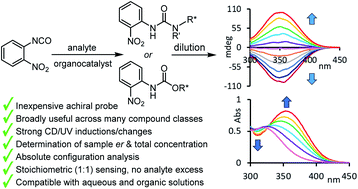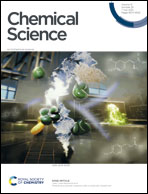Rapid organocatalytic chirality analysis of amines, amino acids, alcohols, amino alcohols and diols with achiral iso(thio)cyanate probes†
Abstract
The widespread occurrence and significance of chiral compounds does not only require new methods for their enantioselective synthesis but also efficient tools that allow rapid determination of the absolute configuration, enantiomeric composition and overall concentration of nonracemic mixtures. Although chiral analysis is a frequently encountered challenge in the chemical, environmental, materials and health sciences it is typically addressed with slow and laborious chromatographic or NMR spectroscopic techniques. We now show with almost 40 analytes representing 5 different compound classes, including mono-alcohols which are particularly challenging sensing targets, that this task can be solved very quickly by chiroptical sensing with a single, readily available arylisocyanate probe. The probe reacts smoothly and irreversibly with amino and alcohol groups when an organocatalyst is used at room temperature toward urea or carbamate products exhibiting characteristic UV and CD signals above 300 nm. The UV signal induction is not enantioselective and correlated to the total concentration of both enantiomers, the concomitant generation of a CD band allows determination of the enantiomeric composition from the same sample, and the sense of the induced Cotton effect reveals the absolute configuration by comparison with a reference. This approach eliminates complications that can arise when enantiomerically impure NMR derivatizing agents are used and it outperforms time-consuming HPLC protocols. The generation of distinct UV and CD signals at high wavelengths overcomes issues with insufficient resolution of overlapping signals often encountered with chiral NMR solvating agents that rely on weak binding forces. The broad solvent compatibility is another noteworthy and important characteristic of this assay. It addresses frequently encountered problems with insufficient solubility of polar analytes, for example pharmaceuticals, in standard mobile phase mixtures required for chiral HPLC analysis. We anticipate that the broad application spectrum, ruggedness and practicality of organocatalytic chiroptical sensing with aryliso(thio)cyanate probes together with the availability of automated CD multi-well plate readers carry exceptional promise to accelerate chiral compound development projects at reduced cost and with less waste production.



 Please wait while we load your content...
Please wait while we load your content...